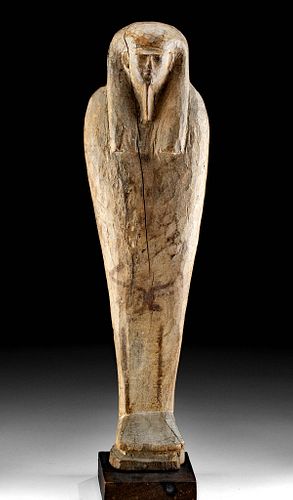Published Tall Egyptian Wood Ptah Sokar Osiris Figure
Lot 5d
About Seller
Artemis Fine Arts
686 S Taylor Ave, Ste 106
Louisville, CO 80027
United States
Selling antiquities, ancient and ethnographic art online since 1993, Artemis Gallery specializes in Classical Antiquities (Egyptian, Greek, Roman, Near Eastern), Asian, Pre-Columbian, African / Tribal / Oceanographic art. Our extensive inventory includes pottery, stone, metal, wood, glass and textil...Read more
Categories
Estimate:
$7,500 - $11,250
Absentee vs Live bid
Two ways to bid:
- Leave a max absentee bid and the platform will bid on your behalf up to your maximum bid during the live auction.
- Bid live during the auction and your bids will be submitted real-time to the auctioneer.
Bid Increments
| Price | Bid Increment |
|---|---|
| $0 | $25 |
| $300 | $50 |
| $1,000 | $100 |
| $2,000 | $250 |
| $5,000 | $500 |
| $10,000 | $1,000 |
| $20,000 | $2,500 |
| $50,000 | $5,000 |
| $100,000 | $10,000 |
| $200,000 | $20,000 |
About Auction
By Artemis Fine Arts
Jun 10, 2021
Set Reminder
2021-06-10 10:00:00
2021-06-10 10:00:00
America/New_York
Bidsquare
Bidsquare : Exceptional Antiquities | Asian | Ethnographic
https://www.bidsquare.com/auctions/artemis-gallery/exceptional-antiquities-asian-ethnographic-7012
Museum-worthy examples of Egyptian, Greek, Roman, Viking, Near Eastern, Far East / Asian, Pre-Columbian, African / Tribal, Oceanic, Native American, Spanish Colonial, Russian, Fossils, Ancient Jewelry, Fine Art, so much more! Artemis Fine Arts info@artemisfinearts.com
Museum-worthy examples of Egyptian, Greek, Roman, Viking, Near Eastern, Far East / Asian, Pre-Columbian, African / Tribal, Oceanic, Native American, Spanish Colonial, Russian, Fossils, Ancient Jewelry, Fine Art, so much more! Artemis Fine Arts info@artemisfinearts.com
- Lot Description
Egypt, Late Dynastic to Ptolemaic Period, ca. 664 to 30 BCE. A hand-carved wooden statue depicting Ptah-Sokar-Osiris in his human-faced form. Figures like this example would have once been part of a larger figurative box for funerary rituals. This is the Osiris portion of the box, shown in mummiform with fused legs and standing atop an integral rectangular plinth which would have attached to the separate wooden sarcophagus box. Both sides of the body and areas of the face are decorated with black bitumen would have perhaps outlined certain colorful embellishments. The face protrudes out from the lappets of a tripartite with and features a false beard, a wide mouth with slightly indented corners, a slender nose, and eyes decorated with additional bitumen. A mortise atop the head still contains a fragment of the original dowel once at the base of an intricate crown. Size: 5" W x 17.875" H (12.7 cm x 45.4 cm); 18.9" H (48 cm) on included custom stand.
Ptah Sokar Osiris is one of the most complicated concepts of Egyptian mythology. The figure shown here represents the god's three parts: Ptah, the creator god of Memphis; Sokar, the patron of the Memphite necropolis; and Osiris, the god of the afterlife and lord of the underworld. All three are depicted in mummy forms; Osiris and Ptah as men, and Sokar as a falcon. Together, they tell a story of birth, death, and resurrection.
These figures became popular after ca. 1000 BCE and are associated with elite burials. In each, the god stands atop a box with a simple lid; a linen-wrapped mummy made of vegetable matter would be placed into the hollow box to represent rebirth in the afterlife (the earliest examples instead had funerary papyri placed inside of them). This "mummy" was a substitute image of the deceased, and when it sprouted, it would symbolize rebirth. The entire artifact would be painted with rich colors and decorated with hieroglyphics, however those on this example have worn away with time. Items like these were almost certainly made by priests as part of the funerary ritual. This figure represents the complex religious iconography of ancient Egypt and serves as a good example that this religion and culture was not unchanging over the vast time period that it lasted; instead, new practices and gods arose over time.
Published: J. Eisenberg, Art of the Ancient World, Vol. XX (2009), no. 188
Cf. The Metropolitan Museum of Art, accession number 26.2.41
This piece has been searched against the Art Loss Register database and has been cleared. The Art Loss Register maintains the world’s largest database of stolen art, collectibles, and antiques.
Provenance: ex-private French collection, acquired from the Paris art market in 2007
All items legal to buy/sell under U.S. Statute covering cultural patrimony Code 2600, CHAPTER 14, and are guaranteed to be as described or your money back.
A Certificate of Authenticity will accompany all winning bids.
We ship worldwide and handle all shipping in-house for your convenience.
#165067Original sarcophagus box figure once stood atop of is missing as shown. Small chips to bottom of feet and integral platform, with a few stable pressure fissures to body and head, fragment of original crown dowel still inside head, and wear to original pigment and bitumen, otherwise intact and excellent. Beautiful patina throughout and faint remains of original bitumen visible in scattered areas.Condition
- Shipping Info
-
All shipping is handled in-house for your convenience. Your invoice from Artemis Gallery will include shipping calculation instructions. If in doubt, please inquire BEFORE bidding for estimated shipping costs for individual items.
-
- Buyer's Premium



 EUR
EUR CAD
CAD AUD
AUD GBP
GBP MXN
MXN HKD
HKD CNY
CNY MYR
MYR SEK
SEK SGD
SGD CHF
CHF THB
THB















